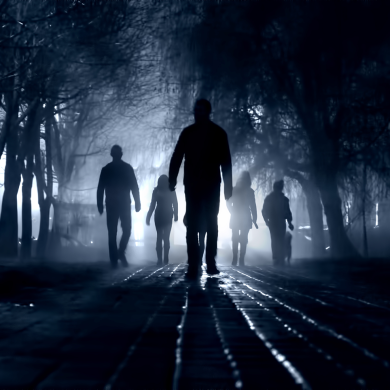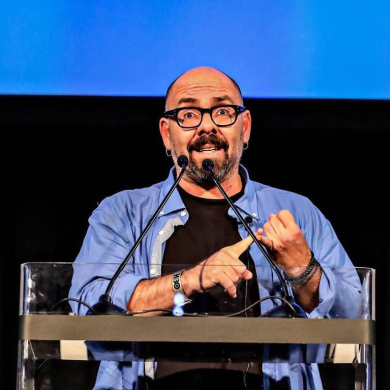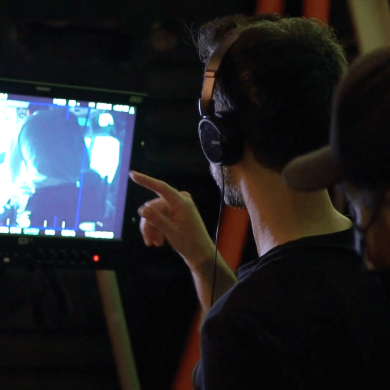By Justin Sanders
There are so many big pleasures we miss about going to movie theaters – the popcorn, the velvety seats, the camaraderie – that it’s easy to overlook the small ones, like movie posters. But the life-sized posters lining the walls at the cinema are an intrinsic part of the movie-going experience, and some of them have become as iconic as the movies themselves.
Dustin Stanton has been a driving force behind many of those iconic posters, for films as varied as Twin Peaks: Fire Walk With Me, Jackass: The Movie, V for Vendetta, and 8 Mile. A longtime collaborator with Paul Thomas Anderson, he has also worked on every one of The Master filmmaker’s movie campaigns since Magnolia.
Now a creative director for Eclipse advertising, Stanton got into entertainment marketing the hard way, with an agency gig delivering packages before he had even graduated high school. “Right away, I got to know so many amazing creatives in the advertising business, and I just started learning from them,” he told CreativeFuture.
Today, his work could involve anything from a poster to “a billboard, the side of a bus, skywriting, or even an interactive installation,” he said, and his clientele includes some of the biggest media brands in the world, including Netflix, FX, Warner Bros., and every now and then, even CreativeFuture.
We caught up with Stanton to talk about setting aside his early dreams of being a rock and roll star, bypassing college, and surviving the 2008 recession to emerge in his field even stronger.
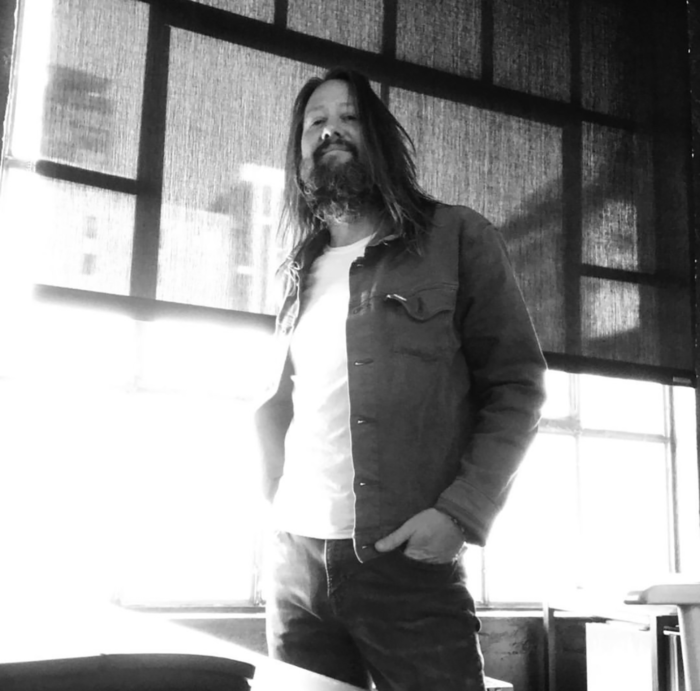
JUSTIN SANDERS: Let’s start with the basics, Dustin. What exactly does a creative director do?
DUSTIN STANTON: Well, there are a lot of different divisions a creative director can operate in. Some creative directors are in social media, some are in strategy, others are in commercials, and so on. I’m primarily in print advertising. These days, with all the ways there are to engage with a still image, they call what I do “key art.”
When a client has a movie, an album, a concert, or some other event they want to advertise, they come to me and say, “I need an image that conveys this concept.” Then it’s up to me and our team to explore creative options and how to execute them.
Many people ask me if I draw or paint – and yeah, I do. I can. But my role as creative director is to figure out whether a project wants to be a drawing or a painting in the first place – or does it want to be a pen-and-ink illustration? Or does it want to be silkscreen type of thing, or a photo shoot that we have to do with the talent involved? It’s my job to determine that concept and then go in whatever direction the client approves of by executing with a team of art directors, graphic designers, and whoever else might be needed.
JS: Entertainment marketing is a massive and influential industry, and yet I think most people probably don’t give much thought to it unless they’re actually working in it. Did you always want to be an art director turned creative director in the movie business?
DS: No, I wanted to be a rock and roll star! I’m a guitar player and had a band in high school and we were getting interest early in my career. It became a choice between 1) continuing to push hard to become a musician in the early ’90s in Los Angeles – where a million other people were doing the same thing – or 2) getting a cushy job at an agency.
I made the jump to the agency job and quit the band. It was sort of a bummer but ultimately, I think it was the best choice for me.
JS: How did you get your first job at an agency?
DS: Well, you’ll have to get into your time machine because I got into this business in 1989. I was an art student in high school and was looking to get a job. My art teacher had a connection at an agency that needed someone to be a driver, to deliver packages to and from all the major studios. All you needed to do the job was a car, auto insurance, and a willingness to learn and grow.
I went to their office for an interview and found myself walking down a hallway that was lined with all of these amazing movie posters. I was really enchanted by it at that time. And then I was hired and right away I got to know so many amazing creatives in the advertising business, and I just started learning from them.
JS: Did you study this field in college as well?
DS: I didn’t get to go to college. I kind of cheated a little bit – I got a really great education from people who actually DID go to art school, but without amassing the student debt. I got the delivery job the second semester of my senior year in high school and just found myself in the trenches, running errands, getting milk for the coffee and filling carbon dioxide tanks. I quickly began helping with production and assisting art directors with airbrushing and X-Acto blade work. We didn’t have Photoshop. We had to airbrush photographs back then, which was a real skill that had to be learned – and there were amazing retouch artists who could make a very good living by removing a pimple from someone’s face or brightening their teeth.
JS: What was it like working in the print department of an ad agency in the late ‘80s?
DS: There was a lot more movement before computers. This was back when they were still doing newspaper ads that were paste-up and the paste-up and production rooms at an agency were like bullpens with all this banter and physicality. There would be people running around getting rub-on type or going to the cabinet for felt pens, spray mount, and other production supplies. You had to know how to use an X-Acto Knife. You had to know how to use a compass and a rapidograph pen and how to clean that pen and how to use a stat camera. There were all these technical skills that have gone by the wayside now. It was an interesting time.
JS: As you said, you produce all kinds of work – but the most immediately recognizable pieces in your portfolio are movie posters. Punch Drunk Love, 8 Mile, Resident Evil – the list goes on and on. Walk us through the process of making a poster for a movie’s print campaign.
DS: Each new project is unique. No two are alike. Each time we begin a new project from somebody, whether it’s a movie poster or an album cover or a photo shoot or an experiential thing, or whatever, you start with a set of assets that they give you. Those could be anything from photos to the story of the project itself – and then you just play. You get in the sandbox. As a creative director, if you have art directors that like to get in there and explore, you can do great things
JS: Okay, since it’s different each time out, let’s zoom in on one project in particular. Walk us through the process of making the poster for Paul Thomas Anderson’s Punch Drunk Love.
DS: PDL was the second film I worked on with Paul, after Magnolia. I went to a screening of the film at Warner Brothers before it came out, and Paul was in the audience, too. After we watched the movie, I met with him out in the lobby and he asked, “So what do you think? What’s the moment?”
I said, “It’s that moment when Barry and Lena come together in the hotel and just smash into each other and kiss.”
He agreed and I thought, “Wow, that can’t be it, right? It’s too obvious.” So, we explored a bunch of stuff, going around the horn on a few different approaches – but in the end, it really was that simple. We came back to “the moment.” It’s the point of the movie that Barry and Lena really connect.
JS: I always assumed that film directors don’t have that much involvement with the marketing of their films, but it sounds like Paul Thomas Anderson had a lot of input in that regard. Is that typical?
DS: Again, that’s different each time out. There are times when a filmmaker has a marketing vision and the studio says, “Hey, we love his films. Let’s see what he has to say about marketing.” Other filmmakers just don’t have the desire to market their movies. Paul is not one of those filmmakers – he will cut his own trailers, his own internet TV spots, and his own internet clips.
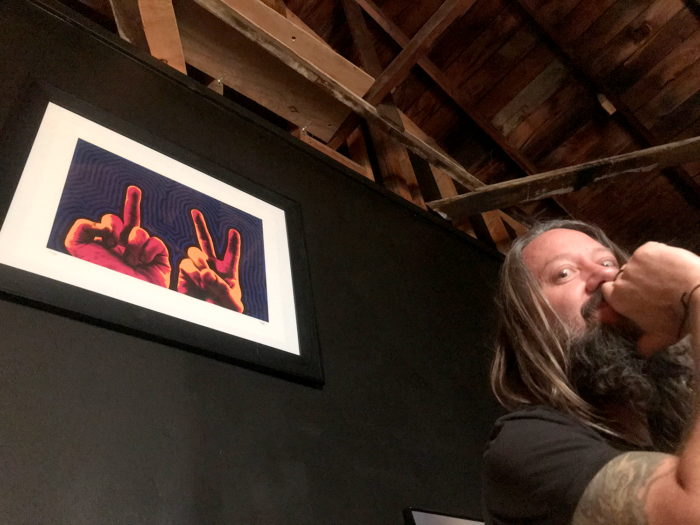
JS: In another recent interview, you said that the breakthrough “moment” in your own career came when you had “to go out there and get your own work.” Can you elaborate on that?
DS: It was 2008 and the economy had taken a hit. I was working at an amazing company called Concept Arts and they had to let me go.
So, I struck out on my own, which can be scary for some folks. After I got my bearings, I did this cool thing where I formed a kind of collective with some other art directors, copywriters, and independent designers, and we would come together and jam on various projects. It blew up a little bit and there were a couple projects that I got on board with that became too big for me to handle.
I realized I needed some infrastructure. I needed not just creative help but billing help and stuff like that. And it was kind of kismet because, as I was having this realization, I got a phone call from a recruiter who said, “There’s a company interested in working with you.” I said, “Great, who is it?”
It was Eclipse. They needed a creative director and I needed some help with some of these bigger projects – so we came together and we’re still working together. That was in 2017.
JS: So, you are on staff with Eclipse?
DS: I am. I work for Eclipse as a full-time creative director, but I also still work independently with some other, non-competitive clients – like singer-songwriter Jackson Browne. I’ve been working with Jackson Browne for over 18 years.
And then, of course, there are groups like CreativeFuture! I love working with mission-driven clients, making a difference if I can.
JS: And we love having your help! The entertainment industry is in a very precarious spot right now, with productions being shuttered and openings being delayed due to the pandemic. Have you noticed a shift on the marketing side as well?
DS: Yes. It’s definitely shifted. At the beginning of this thing, it was kind of scary. Suddenly, you felt the air just go out. There was this lull where it was like, “Okay… things are really slowing down.”
At Eclipse, like at many places, we had to let some people go and furlough some people – it was horrible. But now, we’ve been able to bring it back a little bit. We’re seeing more of a pulse now. In fact, I’m really busy lately, which is great. What we do is really dependent on production. If production starts bubbling up, then that means you’re going to need marketing materials downstream.
One of the things that has been keeping the gas on for our industry during this Covid thing has been streaming services. We’ve been working with companies like Netflix, Disney+, and FX. There’s been a shift in where people are making content available now, and that has definitely helped all of us. And I do believe that people are also going to want to go back to the movies and other live entertainment again in some way. That’s why people are going to drive-ins and to concerts in their cars. I don’t know when or if it’s ever going to be a back to a normal kind of thing, but I do hope the new normal will still include movie theaters.
JS: And it will include movie posters as well… right?
DS: There will always be a place for movie posters. A movie poster is like a king’s portrait. It hangs on the wall for a period of time and can still become iconic in connection to the film it’s representing. You can’t hang a trailer on a wall. You can revisit a trailer on YouTube but there’s an indelible quality that a poster has.
JS: What advice would you have for somebody who is interested in working as a creative in advertising?
DS: Be passionate. It doesn’t matter if you’re at an agency or if you’re a musician, a clothing designer, a set decorator, a painter, or any kind of creative professional. If you want to work as a creative, you have to be passionate. And when somebody sees that in your work, they’ll take notice and then they’ll seek you out. If you’re passionate about something, you’ll want to learn how to do it. You’ll practice it for hours without thinking about it, or you’ll research it for a week and do a paper on it, or whatever it is that lets you engage with it.
So… PASSION. Have it.
JS: Do you have any career goals left to accomplish still?
DS: I believe that old saying, “the journey is the destination”. When you make the journey the destination then you want to get up and do it again each day. I have a lot of personal goals but, professionally speaking, it’s just about getting up every day, doing good work, and creating something that you can be proud of.

